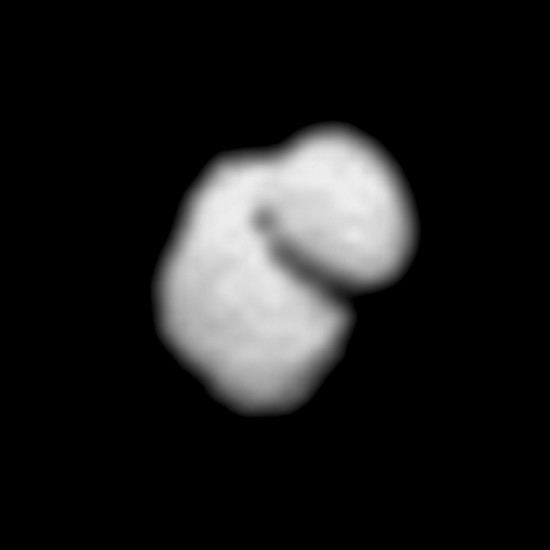
Interpolated image of 67P Churyumov-Gerasimenko. Credit: ESA/Rosetta/MPS for OSIRIS Team MPS/UPD/LAM/IAA/SSO/INTA/UPM/DASP/IDA
Jul 18, 2014
Some surprises as the spacecraft closes in.
The Rosetta Cometary Probe is rapidly approaching Comet 67P Churyumov-Gerasimenko. To the research team’s surprise, it appears to be made of two distinct lobes.
As the catalog of small objects in the Solar System increases, about 15% of the asteroids discovered so far are binary. They are two objects orbiting around a common center of mass. Since asteroids are thought to be loosely compacted “rubble piles”, astronomers speculate that angular momentum on their equators increases because of sunlight’s “impact”, similar to the way a solar sail might be driven by radiation pressure. Their rotational rates increase to such an extent that loosely conglomerated rocks are thrown out of the mass and form another loosely compacted rubble pile in orbit about the first. Sometimes, they will merge together into the unusual shapes that are often seen.
The same thing is also thought to happen to comets. Since comets are “dirty snowballs” in conventional parlance, theories suggest that the same solar radiation can affect them in the same way as asteroids, perhaps more so.
The rubble pile theory of asteroids was created to explain mass anomalies that have been seen in such experiments as Deep Impact. So-called “regolith migration” is also used to explain anomalous structures found on Itokawa and Eros. Gravity on asteroids is minute, so banding, landslides, and layering of surface rocks is from micro-meteor impacts “shaking” asteroids. Over long periods of time, the shaking sorts materials by size and density, in the same way that a jar of sand and pebbles will sort itself when it is shaken. According to the rubble pile theory, that is.
Comets, on the other hand, are said to increase spin because sunlight sublimes their frigid volatile compounds. That sublimation is sometimes violent: what looks like jets of gas are often seen erupting from them as they get close to the Sun. Astrophysicists believe that those gas discharges are what creates the deep craters on comets, as opposed to the impact of another rock.
The electric model of asteroids and comets does not require that one body crash into another one for there to be craters, or for jets of gas to leave voids. Electric arcs can cut surfaces, scoop out material and then accelerate it into space, leaving clean cuts, deep pits and chaotic topography. Since both comets and asteroids exhibit similar surface features, Electric Universe advocates speculate that the two are really one thing and not dirty snowballs versus rocky bodies.
If the electrical stress becomes too great within an asteroid, when it enters the magnetosphere of a planet like Earth, for instance, it may explode into tiny fragments that burn up. If the electrical stress is not too great, as an asteroid flies through another electric field, it might split into two large pieces instead of exploding. The same equalization of potential could take place, but leave behind a pair of orbiting twins that continue on their way.
A theory of electrical fissioning might provide a more reasonable hypothesis than sunlight and angular momentum, although the sunlight theory has the advantage of acceding to the billion-year timescale that dominates science today. Everything takes so much time that the numbers no longer have meaning. To say that sunlight requires a billion years to split an asteroid is science; yet saying that a bluebird can do it is a myth. But given a billion year old bluebird, who knows?
People are typically uncomfortable with events that happen quickly in a large frame of reference. Floods, earthquakes and lightning are frightening and unpredictable when they take place on the scale of cities and counties. No one wants to imagine that such things could take place on the planetary or stellar scale. However, each of the phenomena considered in these pages interrelate in ways that make a compelling conclusion: electricity forms most of what we see in the Solar System and beyond.
Stephen Smith












